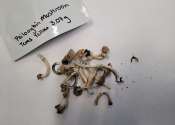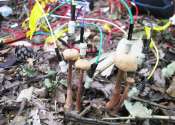New technique measures psilocybin potency of mushrooms
Since the 1970s, the federal government has listed the active ingredients in mushrooms—psilocybin and psilocin—as illegal and having no accepted medical use.

Since the 1970s, the federal government has listed the active ingredients in mushrooms—psilocybin and psilocin—as illegal and having no accepted medical use.
Biochemistry
Mar 19, 2024
0
131

Psilocybe fungi, known colloquially as "magic mushrooms," have held deep significance in Indigenous cultures of Mesoamerica for centuries. They captured the wider world's attention as a psychedelic staple in the 60s and 70s. ...
Evolution
Jan 10, 2024
0
157

Mycelial fibers, the fibrous cells found in fruiting mushroom bodies, have gained momentum as a sustainable material for making leather and packaging owing to their excellent formability. Recently, a team of researchers from ...
Biochemistry
Jan 8, 2024
0
23

Scientists have amassed genome data for dozens of "magic mushroom" isolates and cultivars, with the goal to learn more about how their domestication and cultivation has changed them. The findings, published December 4 in ...
Molecular & Computational biology
Dec 4, 2023
0
355

Ellesmere Island (76°N–83°N) is one of the northernmost islands in the world, along with Greenland and Spitsbergen Island. More than 100 species of vascular plants are distributed across this island in the ice-free areas ...
Plants & Animals
Sep 25, 2023
0
1

A team of researchers in Penn State's College of Agricultural Sciences has identified a compound in white button mushrooms that could potentially benefit gut health in mammals by activating a protective biological response.
Biochemistry
Aug 17, 2023
0
208

Researchers said on Tuesday that an already widely used medical dye reduces the poisonous effects of death cap mushrooms in mice, raising hopes of the first targeted antidote for the world's deadliest mushroom.
Biochemistry
May 16, 2023
1
125

A team of molecular biologists at Johns Hopkins Bloomberg School of Public Health, working with a colleague from the University of Puerto Rico, has found that fungi keep themselves cooler than their surroundings. In their ...

Certain fungi play a critical role in the ecological sustenance of forest trees. Ectomycorrhizal fungi are one such example. Commonly found on pine, oak, and birch trees, ectomycorrhizal fungi form a sheath around the outside ...
Plants & Animals
Apr 28, 2023
1
3143

Shiitake mushrooms get their name from the same place they often source their nutrients—the shii tree, a Japanese relative of the oak. These fungi are part of the genus Lentinula, which have evolved to decompose hardwoods ...
Plants & Animals
Mar 1, 2023
0
175
A mushroom is the fleshy, spore-bearing fruiting body of a fungus, typically produced above ground on soil or on its food source. The standard for the name "mushroom" is the cultivated white button mushroom, Agaricus bisporus; hence the word "mushroom" is most often applied to those fungi (Basidiomycota, Agaricomycetes) that have a stem (stipe), a cap (pileus), and gills (lamellae, sing. lamella) or pores on the underside of the cap.
"Mushroom" describes a variety of gilled fungi, with or without stems, and the term is used even more generally, to describe both the fleshy fruiting bodies of some Ascomycota and the woody or leathery fruiting bodies of some Basidiomycota, depending upon the context of the word.
Forms deviating from the standard morphology usually have more specific names, such as "puffball", "stinkhorn", and "morel", and gilled mushrooms themselves are often called "agarics" in reference to their similarity to Agaricus or their place Agaricales. By extension, the term "mushroom" can also designate the entire fungus when in culture; the thallus (called a mycelium) of species forming the fruiting bodies called mushrooms; or the species itself.
This text uses material from Wikipedia, licensed under CC BY-SA